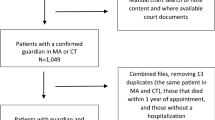Abstract
Typically research on civil commitment has simply compared voluntary and involuntary psychiatric patients and has ignored the process of legal status change. The present study examined patient characteristics associated with legal status change during different points of patients' hospital stays. Results indicated that patients with greater improvement, patients with more severe diagnoses, and non-minority patients were more likely to transition to voluntary status, but only when these transitions occurred early in the hospitalization. Later in the hospitalization, the presence of living arrangements involving family and friends was associated with higher rates of transition to voluntary status.
Similar content being viewed by others
References
Anderson, T.W. & Goodman, L.A. (1957). Statistical inference about Markov chains.Annals of Math Statistics, 28, 89–110.
Bartholomew, D.J. (1982).Stochastic models for social processes. New York: Wiley.
Bishop, Y.M.M., Fienberg, S.E. & Holland, P.W. (1975).Discrete multivariate analysis, Cambridge, Mass: MIT press.
Endicott, J., Spitzer, R.L., Fleiss, J.L. & Cohen, J. (1976). The global assessment scale-a procedure for measuring overall severity of psychiatric disturbance.Archives of General Psychiatry, 33, 766–771.
Faulkner, L.R., McFarland, Bloom, J.D. & Stern, T.O. (1986). A methodology for predicting the effects of changes in civil commitment decision making.Bulletin of the American Academy of Psychiatry and the Law, 14, 71–80.
Faulkner, L.R., McFarland, Bloom, J.D. & Stern, T.O. (1987). A methodology for the analysis of civil commitment detention times and cost.Bulletin of the American Academy of Psychiatry and the Law, 15, 359–370.
Hargreaves, W.A. (1986). Theory of psychiatric treatment systems: An approach.Archives of General Psychiatry, 43, 701–705.
Lane, D., Uyeno, D., Stark, A., Kliewer, E. & Gutman, G. (1985). Forecasting Demand for Long-Term Care Services.Health Services Research, 20, 435–560.
Lane, D., Uyeno, Stark, A., Gutman, G. & McCashin, B. (1987). Forecasting client transitions in British Columbia's long term care program.Health Services Research, 22, 671–707.
Lindsey, K.P., Paul, G.L. & Mariotto, M.J. (1989). Urban psychiatric commitments: Disability and dangerous behavior of black and white recent admissions.Hospital and Community Psychiatry, 40, 286–294.
Lindsey, K.P. & Paul, G.L. (1989). Involuntary commitment to public mental institutions: issues involving the overrepresentation of blacks and assessment of relevant functioning.Psychological Bulletin 106, 171–183.
Monahan, J. & Shah, S.A. (1989). Dangerousness and commitment of the mentally disordered in the United States.Schizophrenia Bulletin, 15, 541–553.
Nicholson, R.A. (1986). Correlates of commitment in psychiatric patients.Psychological Bulletin, 100, 241–250.
Nicholson, R.A. & Horn, J.M. (1987). A discriminant analysis of committed and voluntary psychiatric patients.Journal of Psychiatry Law, 14, 159–176.
Nicholson, R.A. (1988). Characteristics associated change in the legal status of involuntary psychiatric patients.Hospital and Community Psychiatry, 39, 424–429.
Okin, R.L. (1986). The relationship between legal patient characteristics in state hospitals.American Journal of Psychiatry, 143, 1233–1237.
Perry, J., Lavori, P.W. & Hoke, L. (1987). A Markov model for predicting levels of psychiatric service use in borderline and antisocial personality disorders and bipolar type II affective disorder.Journal of Psychiatric Research, 21, 215–232.
Urmer, A.H. (1975). Implications of California's New Mental Health Law.American Journal of Psychiatry, 132, 251–254.
Author information
Authors and Affiliations
Additional information
This research was done as part of a post-doctoral fellowship at the University of California, San Francisco
Rights and permissions
About this article
Cite this article
Cuffel, B.J. Characteristics associated with legal status change among psychiatric patients. Community Ment Health J 28, 471–482 (1992). https://doi.org/10.1007/BF00754192
Issue Date:
DOI: https://doi.org/10.1007/BF00754192




